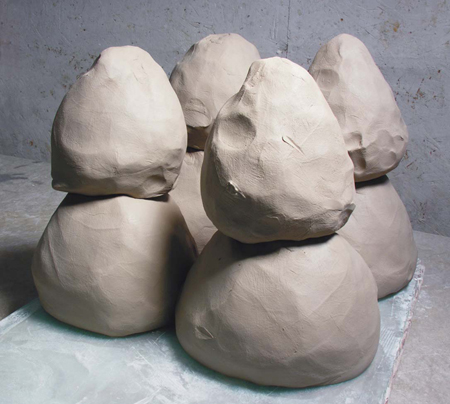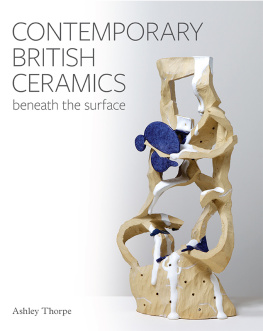Robin Hopper Ceramics
A Lifetime of Works, Ideas and Teachings
Photography by Judi Dyelle and others

This pendant is from northern China or southern Mongolia and likely dates from the mid-19th century. It is a symbolic insignia that has three characters that mean Hundred Family Protector. In communities of more than a hundred families, this would be presented to an elder. My wife found it in an antiques store in Montreal and presented it to me in respect of our blended families and my role as an itinerant teacher to many potters around the world. It has significant meaning to me, and I wear it with pride.
DEDICATION
I dedicate this book to Judi, my wife and partner.
She has now been my constant aide, adviser, critic and
image maker for six books in a row. A heartfelt thanks.
2006 Krause Publications
Published by

Our toll-free number to place an order or obtain
a free catalog is (800) 258-0929.
All rights reserved. No portion of this publication may be reproduced or transmitted in any form or by any means, electronic or mechanical, including photocopy, recording, or any information storage and retrieval system, without permission in writing from the publisher, except by a reviewer who may quote brief passages in a critical article or review to be printed in a magazine or newspaper, or electronically transmitted on radio, television, or the Internet.
The following registered trademark terms and companies appear in this publication:
FIMO polymer clay
Arborite
Formica
Surform woodworkers plane
Mickey Mouse
Tommy gun
Library of Congress Catalog Number: 2006929413
ISBN 13: 978-0-87349-996-5
ISBN 10: 0-87349-996-4
eISBN 13: 978-1-4402-2082-1
Designed by Katie Newby
Edited by Susan Sliwicki
Photography by Judi Dyelle and others
Printed in the United States of America
ACKNOWLEDGMENTS
To my wife, Judi Dyelle: potter, computer whiz, illustrator, photographer and chief sounding board. Once again, Judi and I both particularly wish to thank James Brown and Vic Cromarty for their generosity with advice on digital photography, computer graphics and Mac technology.
To all those, from Adolph Hitler to Lionel Hampton, William Shakespeare to Alistair Sim, Duke Ellington to John Lennon and Paul McCartney, who have made my lifes journey a particularly rich and memorable one.
To my stepdaughter and secretarial assistant, Morgan Saddington, who now has kept me organized for six books in a row.
To Arlene Yarnell, who keeps the studio running while I disappear to write and research, and to Shana Watson, who helps in many ways to keep things on track.
To the late Tom Marsh and Ginny Marsh, who got me into the writing game in the first place, and to Julie Stephani, who seeded the idea from which this particular book germinated.
To the many guides, gurus, mentors and role models from whom Ive learned, sometimes directly, sometimes by example, sometimes by their writings, sometimes by their pots and sometimes by osmosis and without their awareness, including William Staite Murray, Hans Coper, Lucie Rie, Michael Cardew, Mick Casson, Harry HorlockStringer, Bernard Leach, Glenn Nelson, Jim and Nan McKinnell, Tom Coleman, Steve Branfman and Daniel Rhodes.
To the many people and companies who have helped with providing materials, equipment and advice, including John and Darlene Williams of Dallas Trinity Ceramic Supply and Tom Forte of Thomas Stuart Wheels.
To the hundreds of thousands of potters of the last 10,000 years, from whom I continue to learn and gain understanding and inspiration for my own further development. May we tread forever softly in your footprints and honor your collective memory.
To my editor, Susan Sliwicki, whose understanding and encouragement are exemplary, and whose lightness of touch but firmness of vision have kept me striving for perfection, a goal I know Ill never reach, but well worth the effort involved. To the crew at Krause Publications, who continue to improve on my own visions of my books.
I wish to express my gratitude to all of the people who have helped in the development of this book, either directly or by buying my work, books, videos and teachings. Any book is a team effort. To all, my sincere thanks.
Robin Hopper
Victoria, Canada
March 2006
The artist is an exalted craftsperson. In rare
moments of inspiration the grace of heaven
may cause his work to blossom into art, but
proficiency in a craft is essential to any artist.
-Walter Gropius
CONTENTS
INTRODUCTION

The concept for this book was proposed to me by Julie Stephani, former acquisitions editor for Krause Publications, with whom I had a lengthy professional association resulting in five previous books.
Initially, I felt more than a little dubious about the idea, so I asked what value she thought it might have. She said that she felt that my story might be a great help to others going down the same road. I then asked what would be the most important things I could offer. Her reply was that it should include the somewhat unusual life story from early childhood onward, an overview of my 50 years of work, a discussion of my idea sources and a review of what others have said have been some of my more influential or innovative research and teachings.
So, for what it may be worth, this book is a personal analysis of a life, a living and a lifestyle of one seduced by the charms of clay at an early age. It is about experiences, images, ideas, interpretations, risks and realizations how seemingly unrelated, or incoherent, life occurrences coalesce to form new and different life. It brings together art practices, theater practices, travel, architecture, pottery, human history, geology, mineralogy, alchemy, zoology, horticulture and gardens. It is the story of my life in clay and the impact of events that shaped where Ive been and what Ive done.
It is also a love story a somewhat unusual love story! It is about passion, intrigue and obsession. It is a story about a lust for life, a thirst for knowledge, a passion for pots, a mania for mud and minerals and a commitment to furthering the development of ceramic communication and education.
As with most love stories, its plot is full of twists, turns and subplots. It is about an all-consuming addiction to clay that began at about the age of 3 and, at the time of writing, has continued for 64 years.
Experience is like compound interest in a bank the more you have, the quicker it grows and the more you can do with it. The greater the range of experiences, the more interesting or profound the story might be, no matter what the medium!
IMAGES
The images throughout this book fall basically into two categories: those with informative comment about how things have been done and those that are there to promote imagination and generate ideas.
Ideas dont normally come fully formed; they are usually like a seed that requires fertilization before germination can take place. I often use the analogy of the garden for just this reason. Many potters are also great gardeners who utilize the garden for generation of concepts for form, surface and color. Other than recognizing a particular landscape, bird or flower species, they are there to spark mental stimulus. Excessive words might get in the way of personal interpretive visions that may be generated through image alone.
Next page











